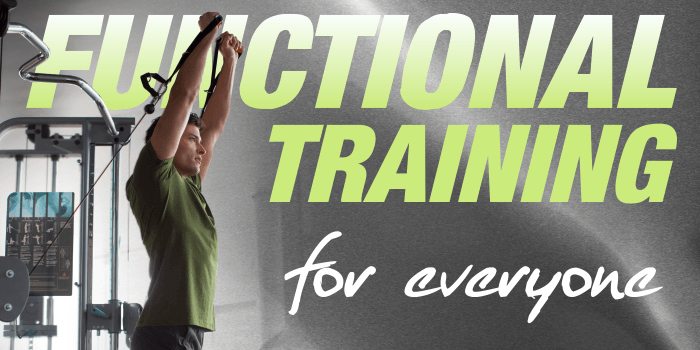
Functional Training… Training for Everyone.

WHAT IS FUNCTIONAL TRAINING?
Functional Training has it's roots in Physical Therapy and Rehabilitation, where it was employed to restore strength and mobility post-injury. Trainers have now adopted functional training as a staple because of it's ability to strengthen the core, increase range of motion, increase power, improve joint stability, and give the exerciser a better quality of life overall. Everyone from professional athletes to grandmothers can benefit. Functional training is infinitely customizable, and can be tailored to everyone's daily living requirements.
At the core of Functional training is: you guessed it, your "CORE". (See what I did there?) This area of the body gets a lot of attention these days in fitness circles, but few people really understand what it entails. As the name implies, this is the epicenter of ALL physical movement. But contrary to what most people believe, the core is not just that elusive 6-8 pack that we see on the cover of magazines while we wait to pay for our ice cream. The core includes all muscles from the top of your pelvis to the bottom of your ribcage - including the back! As anyone with lower back issues will tell you, without a strong core, you are a very dysfunctional human being. Any injury or restriction in this area of the body makes performing even the simplest tasks, like putting on your pants, almost impossible. Ask a new mother who has had a C-section how important your core is. Bending, lifting, reaching, twisting, breathing, blinking... we tend to take these things for granted, until your core is compromised.
Functional training addresses the mobility and strength of this region specifically, while at the same time exercising the peripheral muscles and joints that rely on it.

WHY FUNCTIONAL TRAINING?
STRONG CORE = STRONG BODY. Unlike traditional forms of resistance training (i.e. weight training), where most exercises are performed in a supported position (e.g. seated or lying down) and target very specific muscles one at a time, Functional Training Exercises are typically performed in a standing position, where your core will naturally engage (i.e. flex) in order to resist the force being applied to another part of the body, and literally keep you from falling down. This involves compound movements that will engage many muscle-goups simultaneously. Anyone who has ever slipped while walking on ice (Go Canada) will be very familiar with this concept. In order to stay upright, your core is what engages and (hopefully) saves you from falling. Incidentally, your core is what will be sore later if you "catch yourself" from going down! (e.g. lower back)
Functional Training has exploded in popularity in the last several years, as is evident by the number of facilities dedicated to this form of exercise that have sprang up throughout the world. Competitions are held constantly around the world with some being broadcast on major sports networks. The popularity of Functional Training is due to a number of factors:
Variety: The number and type of Functional Exercises are almost endless. Any movement that a person performs in the course of daily living can be translated into a functional training exercise. The slightest change to these exercises can make a world of difference in how it affects your body. (e.g. body position, grip, speed, etc.) This has the advantage of preventing exercise plateaus, (where your body becomes accustomed to an exercise and progress is stymied) which are common in traditional forms of exercise. The other advantage of variety is psychological. Changing your exercise routine typically will prevent boredom and greatly increase adherence to a healthy lifestyle.
Accessibility: In terms of the variety of equipment used, space requirements, and potentially the low cost, functional training can be very easy to accomplish with either very elaborate equipment, or little to no equipment at all. Whenever possible, to add variety, most trainers would recommend taking advantage of all kinds of functional training, both elaborate and simple! In terms of people… Functional Training means something different to everyone, and can be customized to the user’s daily life.
Portability: As stated above, Functional Training can be accomplished with little to no equipment. Body-weight exercises like push-ups, squats and burpees (squat thrusts) are some of the oldest and still the best forms of functional exercise for your body! In addition, Body Suspension training products (e.g. TRX Suspension Trainers) are extremely portable due to their small size when stored, and can be used in a very small space like a hotel room.
Practicality: Functional Training can help with your job, your sport, your marriage, playing with your children, your grandchildren, longevity, weight loss, not to mention your mental health and the overall physical health benefits that come from consistent exercise in general! As our population ages, Functional Training and it's benefits will become increasingly more prevalent.
Quality of Life: Imagine the possibility of sprinting up the stairs, living pain free, wearing smaller clothes, looking better, feeling better, being stronger mentally and physically... the list goes on and on (and is as varied as people themselves). All of this equates to living a longer, more productive and enjoyable life!

SO WHERE DO I START???
Speak to/hire a qualified trainer. They will assess your needs and recommend a direction for you. Want to exercise at home? Specialty fitness stores have a plethora of options, from very basic, (like a kettlebell or medicine ball) to very elaborate, (like a Hoist Fitness Mi7Smith) for anyone who wants to begin functional training. Specialty stores have fitness experts that will help you find the right solution for you!
Ian Pentland CPT, NWS, NLP – Web Division | Fitness Experience
